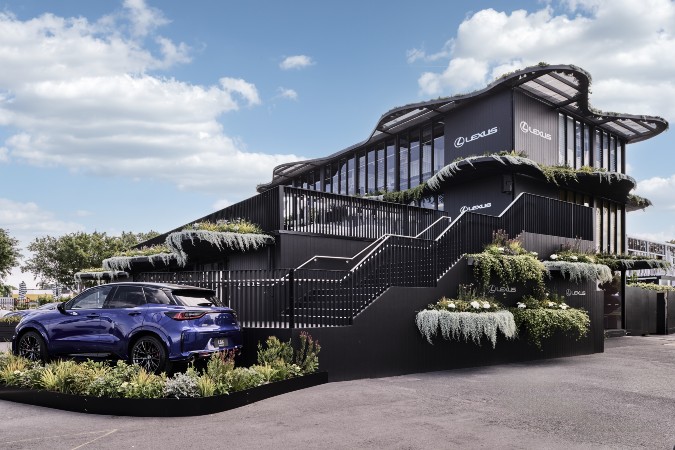The Melbourne-based interior designer is this year’s ambassador for Lexus, at the highly anticipated Melbourne Cup Carnival.
On this occasion, he has just delivered a very special project: the LANDMARK by Lexus Pavilion. Perera sat down with Architecture & Design’s Digital Editor Clémence Carayol to chat about the genesis of this outstanding project and his involvement as Lexus’ ambassador.

LANDMARK by Lexus/Brahman Perera. Photography: Tom Blachford
Architecture & Design: Congratulations on becoming a Lexus ambassador! What does this role mean to you personally and professionally?
Brahman Perera: Thank you, it has been an incredible experience working with Lexus and The Big Group to realise and maximise what this project can be. Since a lot of my background (in terms of both work and life) centers around hospitality, designing a space for one of Australia’s most festive and legacy events has been an absolute honour. Weaving my long-standing interests for theatre and the arts into a space designed around hospitality and festivities was my key instinct around this project, designing a space that is in itself temporary, but lingers in people's memory.
How do you see the values of Lexus aligning with your approach to interior design?
To me, Lexus represents detailing, quality and performance. These three archetypes are also very indicative of what we want to achieve with the renowned LANDMARK by Lexus event. This is to be a space and event that we want to be unique, memorable and stand apart from the rest. It’s not about applying a lens of ‘futuristic’ aesthetics, but rather, thinking about quality and meaningful experiences.

LANDMARK by Lexus/Brahman Perera. Photography: Tom Blachford
Can you share any experiences or memorable moments you’ve had with Lexus so far?
Working alongside a legacy product and company, it is important to design a space that is indicative of their heritage, their innovation and their spirit. Back in winter of this year, the first presentation with the Lexus board and key stakeholders, all zooming in from all around the world. Part of a designer’s role is to communicate and expound the design, and the relationship throughout this project with Lexus has been greatly rewarding for their trust with me and their inherent belief in the design.

LANDMARK by Lexus/Brahman Perera. Photography: Tom Blachford
With the Melbourne Cup approaching, how do you think luxury and design come together in this event?
Inextricably. With such a renowned and legacy event, it is important to design a space as an object of beauty, but also consider what luxury means. To me, luxury isn’t wholly relegated to just how something looks or its quality, luxury is also about the experience. So for LANDMARK by Lexus, the luxury is also in the care and experience of the event, hospitality is luxury. It was a great experience to work with the many collaborators for this event: food, floristry, music, to deliver an experience that is memorable and rewarding.
What do you find most exciting about the intersection of automotive design and interior design?
They do have more in common than at first thought. Both interior and automotive design consider the occupant, and the occupants experience. Materiality and quality also therefore play an important role, but think there can sometimes be a lot of jargon and confusion around tech and innovation having a specific, futuristic aesthetic. I wanted to design for innovation but with a different perspective and create a space that spoke of the brief, but didn’t adhere to the usual visual archetypes around technology.

LANDMARK by Lexus/Brahman Perera. Photography: Tom Blachford
In your opinion, what role does sustainability play in both the automotive industry and interior design today?
I think they’re objectives are similar in a macro sense of materiality and longevity. It was a key consideration for me that this project was a fleeting space, a fleeting experience, so it was important to design a space that embraced pre-existing elements and new interventions could be re-used at a later date. I have experience working with various Greenstar consultants in the past. This allowed me to parlay that knowledge of the requirements for that rating into a considered space that maximised impressions, and minimised waste.
How do you prepare for a high-profile event like the Melbourne Cup, both in terms of personal style and your design work?
For personal style, I decided that I wanted to support and wear the designers and brands I have worked with in the past: Henne, Christian Kimber, and DISSH. So, across each event day (of which there are four), I will be showcasing my client’s designs. In terms of the space, the handover occurred on the day before Derby Day, and it’s important to relinquish control and leave it in the capable hands of the client (The Big Group). A space is always going to find its own way of functioning, so it's important to design with consideration, but also accept any chances.
What advice would you give to aspiring designers looking to merge their passion with luxury brands?
I don’t think there is necessarily a secret to explicate; as I believe the answer is in the work you create, and the relationships you form with people. To be a designer, you have to create work you stand for, but you also have to create and nurture relationships, one can’t exist without the other.
Image: Brahman Perera/Lexus media preview by Magner Media

